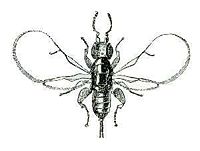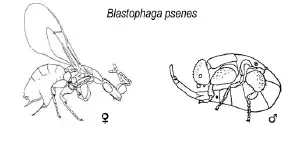Difference between revisions of "Fig wasp" - New World Encyclopedia
Rick Swarts (talk | contribs) |
Rick Swarts (talk | contribs) |
||
| Line 22: | Line 22: | ||
==Overview and description== | ==Overview and description== | ||
| + | The family as presently defined is [[polyphyletic]], including several unrelated lineages whose similarities are based upon their shared association with figs; efforts are underway to resolve the matter, and remove a number of constituent groups to other families, particularly the [[Pteromalidae]] and [[Torymidae]]. Thus, the number of genera in the family is in flux. Probably only the [[Agaoninae]] should be regarded as belonging to the Agaonidae, whilst the [[Sycoecinae]], [[Otitesellinae]] and [[Sycoryctinae]] should be included in the Pteromalidae. Placement of the [[Sycophaginae]] and [[Epichrysomallinae]] remains uncertain. | ||
| + | [[Image:Blastophaga psenes2.png|thumb|left]] | ||
| + | Among the Agaonidae, the female is a normal insect, while the males are mostly wingless. The males' only tasks are to mate with the females while still within the fig [[syconium]] and to chew a hole for the females to escape from the fig interior. This is the reverse of [[Strepsiptera]] and the [[bagworm]], where the male is a normal insect and the female never leaves the host. | ||
| + | ===Figs and fig wasps=== | ||
| + | '''Fig''' is the common name given to any [[vine]], [[shrub]], or [[tree]] in the [[genus]] '''Ficus''' of the mulberry family, Moraceae. The term also is used for the sweet, edible, round to oval, multiple fruit of the common fig, ''Ficus carica,'' which is of commercial importance. The soft flesh of this multiple [[fruit]] has many tiny, seedlike fruits. The fruit of many other species are edible, though not widely consumed. | ||
| + | In addition to the common fig, ''Ficus carica,'' the most well known species, other examples of figs include the [[banyan]]s and the [[sacred fig]] (Peepul or Bo) tree. | ||
| + | Among ecological values is the harmonious relationship between fig trees and [[fig wasp]]s, with the very small wasps [[pollination|pollinating]] the trees— typically one particular species of wasp for each species of tree— while the flowers provide nourishment and a safe haven for the wasps. | ||
| − | + | Most figs come in two sexes. One is hermaphrodite. These are called ''caprifigs,'' from the [[Caprinae]] subfamily or goats, as in fit for eating by goats (sometimes called "inedible"). The other one is female, as the male flower parts fail to develop; this produces the "edible" fig. [[Fig wasp]]s grow in caprifigs but not in the other because the female trees' female flower part is too long for the wasp to successfully lay her eggs in them. Nonetheless, the wasp pollinates the flower with pollen from the fig it grew up in, so figs with developed seeds also contain dead fig wasps almost too tiny to see. | |
| − | |||
| − | |||
Most fig [[inflorescence]]s contain three kinds of [[flower]]s: male, short female, and long female. Female fig wasps can reach the ovaries of short female flowers with their ovipositors, but not long female flowers. Thus the short flowers grow wasps, whereas the long flowers become seeds. In figs of this sort, the crunchy bits in the fruit contain both seeds and wasps. However, there are several commercial and ornamental varieties of fig that are self-fertile and do not require pollination; these varieties are not visited by fig wasps. | Most fig [[inflorescence]]s contain three kinds of [[flower]]s: male, short female, and long female. Female fig wasps can reach the ovaries of short female flowers with their ovipositors, but not long female flowers. Thus the short flowers grow wasps, whereas the long flowers become seeds. In figs of this sort, the crunchy bits in the fruit contain both seeds and wasps. However, there are several commercial and ornamental varieties of fig that are self-fertile and do not require pollination; these varieties are not visited by fig wasps. | ||
| + | |||
| + | There typically is only one species of wasp capable of fertilizing the flowers of each species of fig, and therefore plantings of fig species outside of their native range results in effectively sterile individuals. For example, in [[Hawaii]], some 60 species of figs have been introduced, but only four of the wasps that fertilize them have been introduced, so only four species of figs produce viable seeds there. | ||
| + | |||
| + | |||
Pollinating fig wasps (Agaoninae) are specific to specific figs. The common fig ''Ficus carica'' is pollinated by ''[[Blastophaga]] psenes''. | Pollinating fig wasps (Agaoninae) are specific to specific figs. The common fig ''Ficus carica'' is pollinated by ''[[Blastophaga]] psenes''. | ||
Revision as of 23:27, 17 May 2008
| Fig wasps | ||||||||||||||
|---|---|---|---|---|---|---|---|---|---|---|---|---|---|---|
 Blastophaga psenes
| ||||||||||||||
| Scientific classification | ||||||||||||||
| ||||||||||||||
|
Fig wasps are wasps of the family Agaonidae which pollinate figs or are otherwise associated with figs.
Overview and description
The family as presently defined is polyphyletic, including several unrelated lineages whose similarities are based upon their shared association with figs; efforts are underway to resolve the matter, and remove a number of constituent groups to other families, particularly the Pteromalidae and Torymidae. Thus, the number of genera in the family is in flux. Probably only the Agaoninae should be regarded as belonging to the Agaonidae, whilst the Sycoecinae, Otitesellinae and Sycoryctinae should be included in the Pteromalidae. Placement of the Sycophaginae and Epichrysomallinae remains uncertain.
Among the Agaonidae, the female is a normal insect, while the males are mostly wingless. The males' only tasks are to mate with the females while still within the fig syconium and to chew a hole for the females to escape from the fig interior. This is the reverse of Strepsiptera and the bagworm, where the male is a normal insect and the female never leaves the host.
Figs and fig wasps
Fig is the common name given to any vine, shrub, or tree in the genus Ficus of the mulberry family, Moraceae. The term also is used for the sweet, edible, round to oval, multiple fruit of the common fig, Ficus carica, which is of commercial importance. The soft flesh of this multiple fruit has many tiny, seedlike fruits. The fruit of many other species are edible, though not widely consumed.
In addition to the common fig, Ficus carica, the most well known species, other examples of figs include the banyans and the sacred fig (Peepul or Bo) tree.
Among ecological values is the harmonious relationship between fig trees and fig wasps, with the very small wasps pollinating the trees— typically one particular species of wasp for each species of tree— while the flowers provide nourishment and a safe haven for the wasps.
Most figs come in two sexes. One is hermaphrodite. These are called caprifigs, from the Caprinae subfamily or goats, as in fit for eating by goats (sometimes called "inedible"). The other one is female, as the male flower parts fail to develop; this produces the "edible" fig. Fig wasps grow in caprifigs but not in the other because the female trees' female flower part is too long for the wasp to successfully lay her eggs in them. Nonetheless, the wasp pollinates the flower with pollen from the fig it grew up in, so figs with developed seeds also contain dead fig wasps almost too tiny to see.
Most fig inflorescences contain three kinds of flowers: male, short female, and long female. Female fig wasps can reach the ovaries of short female flowers with their ovipositors, but not long female flowers. Thus the short flowers grow wasps, whereas the long flowers become seeds. In figs of this sort, the crunchy bits in the fruit contain both seeds and wasps. However, there are several commercial and ornamental varieties of fig that are self-fertile and do not require pollination; these varieties are not visited by fig wasps.
There typically is only one species of wasp capable of fertilizing the flowers of each species of fig, and therefore plantings of fig species outside of their native range results in effectively sterile individuals. For example, in Hawaii, some 60 species of figs have been introduced, but only four of the wasps that fertilize them have been introduced, so only four species of figs produce viable seeds there.
Pollinating fig wasps (Agaoninae) are specific to specific figs. The common fig Ficus carica is pollinated by Blastophaga psenes.
Life Cycle
The life cycle of the fig wasp is closely intertwined with that of the fig tree they inhabit. The wasps that inhabit a particular tree can be loosely divided into two groups; pollinating and non-pollinating. The pollinating variety forms a mutually beneficial symbiosis with the tree, whereas the non-pollinating variety is parasitic. Both life cycles, however, are very similar.
Though the lives of individual species differ, a general fig wasp life cycle is as follows. In the beginning of the cycle, a mature female pollinator wasp enters a receptacle ("fruit") through a small natural opening, the ostiole, passes through the mouth of the fig, which is covered in male flowers, and deposits her eggs in the cavity, which is covered in female flowers, by oviposition. Forcing her way through the ostiole, she often loses her wings and most of her antennae. In depositing her eggs, the female also deposits pollen she picked up from her original host fig. This pollinates some of the female flowers on the inside surface of the fig and allows them to mature. After pollination, there are several species of non-pollinating wasps which deposit their eggs before the figs harden. These wasps act as parasites to either the fig or the pollinating wasps. As the fig develops, the wasp eggs hatch and develop into larvae. After going through the pupal stage, the mature male’s first act is to mate with a female. The males of many species lack wings and are unable to survive outside the fig for a sustained period of time. After mating, a male wasp begins to dig out of the fig, creating a tunnel for the females to escape through.
Once out of the fig, the male wasps quickly die. The females leave the figs, picking up pollen as they do. They then fly to another tree of the same species where they deposit their eggs and allow the cycle to begin again.
Genera
Genera currently included in Agaonidae according to the Universal Chalcidoidea Database:
|
|
|
|
ReferencesISBN links support NWE through referral fees
- Rasplus, J.-Y., Kerdelhuse, C., Clainche, I. le & Mondor, G. 1998. Molecular phylogeny of fig wasps. Agaonidae are not monophyletic. Comptes Rendus de l'Academie des Sciences (III) 321(6):517-527
External links
- Video: Interaction of figs and fig wasps Multi-award-winning documentary
- Figs and fig wasps
- Images of fig wasps on Morphbank, a biological image database
Credits
New World Encyclopedia writers and editors rewrote and completed the Wikipedia article in accordance with New World Encyclopedia standards. This article abides by terms of the Creative Commons CC-by-sa 3.0 License (CC-by-sa), which may be used and disseminated with proper attribution. Credit is due under the terms of this license that can reference both the New World Encyclopedia contributors and the selfless volunteer contributors of the Wikimedia Foundation. To cite this article click here for a list of acceptable citing formats.The history of earlier contributions by wikipedians is accessible to researchers here:
The history of this article since it was imported to New World Encyclopedia:
Note: Some restrictions may apply to use of individual images which are separately licensed.

